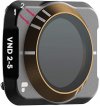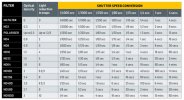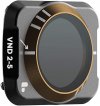It's a little more complicated than that but I'll try to make it simple. If your going to use ND filters you need to take control of the other factors that make up the exposure.
Note that the following assumes you're flying a drone with a fixed aperture.
If you're shooting video, the shutter should be twice the FPS or frame rate. If you're on the PAL standard the rate will likely be 25 and that would cause you to select a shutter speed 1/50th of a second.
Next, set the ISO to it's lowest setting.
Finally, dial the ND filter until the exposure is correct. You may sometimes find, that one of the settings is in between the stops - in this case I go for slightly underexposed and then go back into the ISO and raise slightly, on the
Mavic 2 Pro I try not to go over 400 and as I mentioned the ideal ISO is the lowest.
So a typical drone setup on a sunny day would be -
Fixed aperture at 2.8
Shutter at 1/50th (twice frame rate if on PAL standard)
ISO at 100 or lowest
ND 16 (4 STOPs) as a starting point.
These setting are just an example of where you could start.
Good Luck















